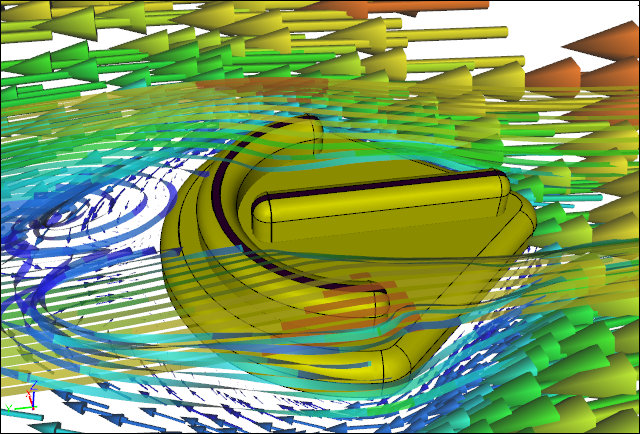
CFD Provides Insight Into Mystery Fossils
Fossilized imprints of Parvancorina from over 500 million years ago have puzzled paleontologists for decades. What makes it difficult to infer their behavior is that Parvancorina have none of the familiar features we might expect of animals, e.g., limbs, mouth. In an attempt to shed some light on how Parvancorina might have interacted with their environment researchers have enlisted the help of Computational Fluid Dynamics (CFD).
 CFD Water Flow Simulation over a Parvancorina: Forward directionIllustration only, not part of the study
CFD Water Flow Simulation over a Parvancorina: Forward directionIllustration only, not part of the study
Simon Darroch at Vanderbilt University and Imran Rahman at Oxford University created 3D models of 3 types of Parvancorina and performed CFD simulations that mimic the water conditions where the creatures lived. By looking at the variation of drag according to the orientation of the creature they showed that there were preferred positions that minimized drag. Their hypothesis is that rather than being fixed to a river bed the Parvancorina likely were mobile and thus able to orient themselves to feed and, in their preferred minimum drag orientation, maintain their position in the water with less effort.
 CFD Water Flow Simulation over a Parvancorina: Backward directionIllustration only, not part of the study
CFD Water Flow Simulation over a Parvancorina: Backward directionIllustration only, not part of the study
Maybe the Parvancorina could also use their maximum drag orientation, much like a parachute, to ride water currents in their hunt for food.
Recent blog posts
- CFD Simulates Distant Past
- Background on the Caedium v6.0 Release
- Long-Necked Dinosaurs Succumb To CFD
- CFD Provides Insight Into Mystery Fossils
- Wind Turbine Design According to Insects
- Runners Discover Drafting
- Wind Tunnel and CFD Reveal Best Cycling Tuck
- Active Aerodynamics on the Lamborghini Huracán Performante
- Fluidic Logic
- Stonehenge Vortex Revealed as April Fools' Day Distortion Field
